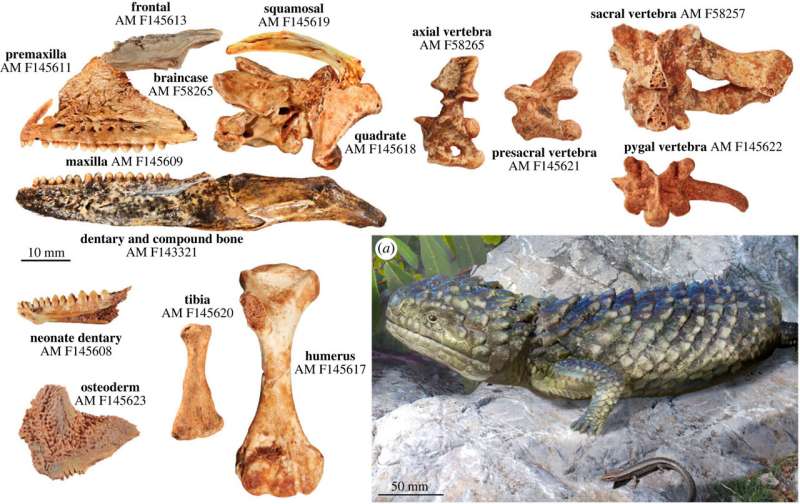June 14, 2023 report
This article has been reviewed according to Science X's editorial process and policies. Editors have highlighted the following attributes while ensuring the content's credibility:
fact-checked
peer-reviewed publication
trusted source
proofread
Ancient extinct skink was orders of magnitude bigger than any skink alive today

A team of researchers from Flinders University with ties to the South and Western Australian Museums has confirmed the identification of one of the largest ancient lizards ever found. In their paper published in Proceedings of the Royal Society B, the group describes the means by which the specimen was found and identified and its physical characteristics.
In 2016, scientists working at a Wellington Cave dig site in New South Wales, Australia, discovered lizard fossils. Subsequent study suggested that they came from two species of large, ancient lizards. In this new effort, a closer look has shown that all the fossils were those of a single lizard and that it was one of the largest ever found.
Since the initial find, workers at the site have uncovered many more samples of the giant lizard, ranging in age and size. The findings led to comparisons with ancient lizard fossils found at other sites and in museums, which turned out to be the same species of lizard. They found that the lizard species lived from approximately 2 million years ago to around 47,000 years ago.
The species has been named Tiliqua frangens, and in addition to its large size, it has other unique features. The lizards were covered in thick, spikey armor that clearly served as plating to protect them from predators, though such predators would have had to be quite large, as the ancient lizards grew to 60 centimeters in length and weighed up to 2.4 kilograms. For comparison purposes, the researchers note, the largest modern skinks grow to just 35 centimeters and weigh on average 2 grams. They suggest that of modern species, the ancient skink most closely resembles the blue-tongued skink.
The researchers describe the ancient skink as "one of the most bizarre lizards found in recent times" because of its size and armor. They note that it had a wide, heavyset body, reminiscent of an alligator, which meant it was likely a slow mover and not agile. They suggest its size and plating allowed the skink to forage in the open during daylight hours, and like its modern relatives, it ate plants. They note that because they found examples of the lizard at different ages, they were able to track its growth and development.
More information: Kailah M. Thorn et al, A giant armoured skink from Australia expands lizard morphospace and the scope of the Pleistocene extinctions, Proceedings of the Royal Society B: Biological Sciences (2023). DOI: 10.1098/rspb.2023.0704
Journal information: Proceedings of the Royal Society B
© 2023 Science X Network





















